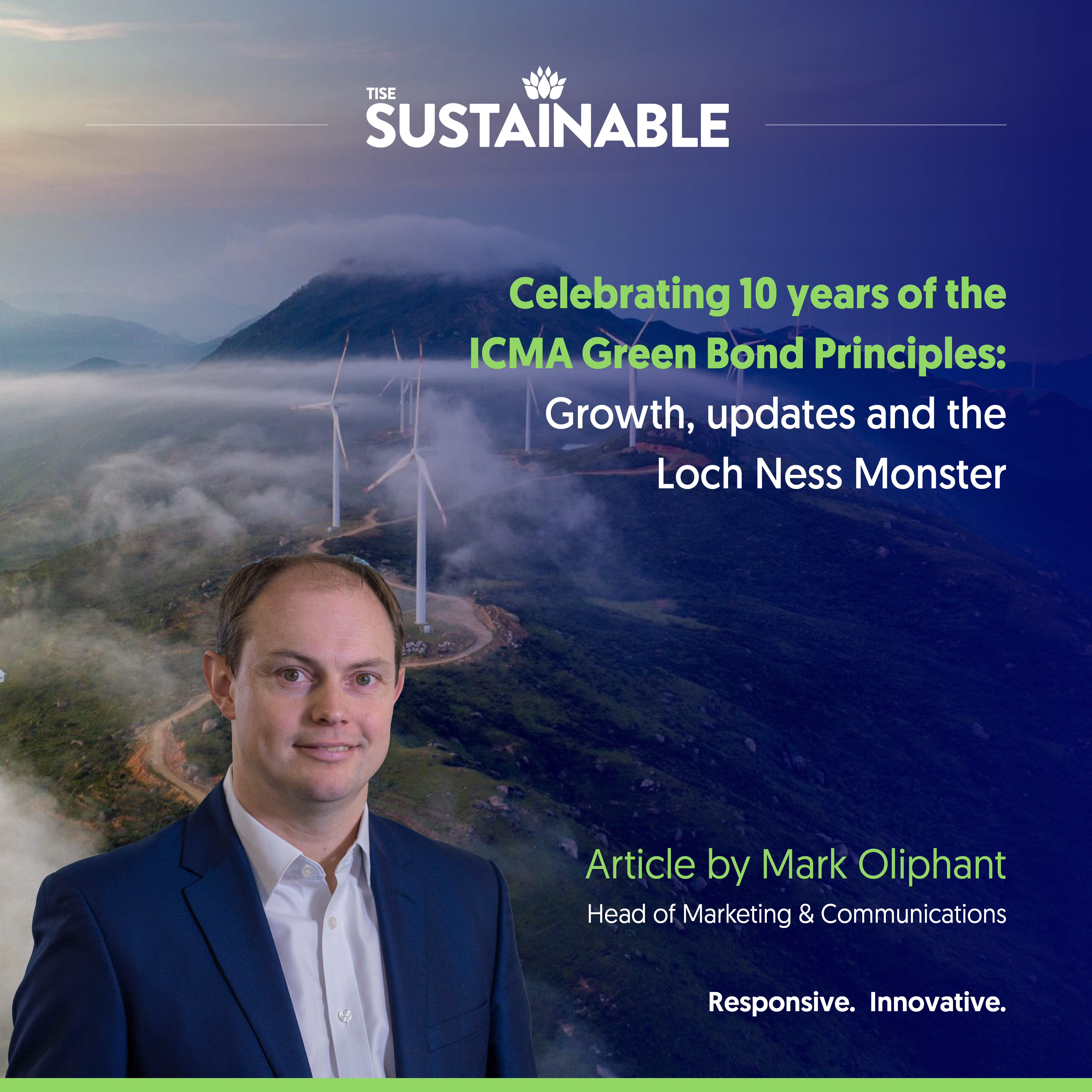In this article, Mark Oliphant, Head of Marketing & Communications at The International Stock Exchange (TISE), examines the debate which took place at the recent 10th Annual Conference of the Principles hosted by the International Capital Market Association (ICMA).
This week the ICMA hosted the 10th Annual Conference of the Principles in Amsterdam and I was fortunate enough to be able to attend the event virtually.
It marks 10 years since ICMA first published the Green Bond Principles as a voluntary framework for issuers to follow when issuing green bonds and it has become the leading standard promoting the role of debt capital markets in financing the transition to environmental sustainability.
Today, ICMA has a suite of Green, Social, Sustainable and Sustainability-Linked Bond Principles (collectively, the Principles) and which we at TISE see as the most common frameworks utilised as qualifying credentials among issuers/securities admitted to our sustainable finance segment, TISE Sustainable.
So far, so straightforward. It was quite the surprise then to find the Loch Ness Monster making an appearance at this event. But, of course, the point was that it was actually a non-appearance. More of that later.
Growth
The Principles are the leading framework globally for the issuance of sustainable bonds and the de facto standard referenced by over 98% of sustainable bond issuance internationally. The Principles underpin a market representing near $5 trillion in aggregate, the largest source of debt capital finance available for sustainable projects and transition finance. Approximately $1 trillion a year of new sustainable bonds are issued each year, representing 12% of the total annual debt capital market issuance.
"The Principles are the leading framework globally for the issuance of sustainable bonds..."
Bryan Pascoe, Chief Executive of ICMA, noted that despite this success story, new issuance levels have hit a plateau over the last 18 months, in particular among Sustainability-Linked Bonds (SLBs), and so it is incumbent upon ICMA and its membership to push forward with new standards and guidance which reflects and supports the latest market best practice.
Updates
It was in this context that the event provided the opportunity for ICMA to announce two new publications and a wider set of resources:
- Guidance for green enabling projects: A great number of green enabling projects, vital to the value chain of green projects, are not themselves explicitly considered green but remain critical to these eligible green projects. This new guidance helps explain what is in scope to be considered a green enabling project (e.g. mining of materials for electric vehicle batteries) and how they should be managed. This encompasses both the induced and avoided emissions, as well as the management of related environmental and social risks.
- Guidelines for Sustainability-Linked Loan financing Bonds (SLLBs): Developed jointly with the Loan Market Association (LMA), these guidelines define a dedicated bond instrument designed for issuers wishing to finance or re-finance a portfolio of eligible Sustainability-Linked Loans (SLLs)
There has also been a series of updates to the SLB Principles, with clarifications to support KPI selection, an expansion of the SLB KPIs Registry (as well as additional KPIs for sovereign issuers), and a new SLB disclosure data checklist to support greater standardisation. There is also a new annex to the Impact Reporting Handbook covering potential environmental and/or social benefits and risks associated with eligible project categories for green bonds.
Loch Ness Monster
Looking broader, Emmanuel Faber, Chair of International Sustainability Standards Board (ISSB), described the development and increased adoption of ISSB disclosure and reporting recommendations. Based on traditional accounting requirements, 20 countries representing 50% of global GDP have now agreed to adopt ISSB recommendations during the next few years. At the same time, ISSB has taken over from the Taskforce on Climate-related Financial Disclosures (TCFDs) the responsibility for monitoring climate-related disclosures, it has been endorsed by the International Organisation of Securities Commissions (IOSCO) and there is an interoperability agreement between the EU’s project and the wider global initiative.
"The Principles continue to focus on disclosure and transparency, believing that investors themselves should decide whether something is green enough."
The Principles continue to focus on disclosure and transparency, believing that investors themselves should decide whether something is green enough. The EU has taken a different path, for example through the introduction of the EU Taxonomy for Sustainable Activities and the EU Green Bond Standard, with labels providing an assessment of an investment’s green hue (and as such, providing more definition around what constitutes greenwashing). Defining green at such an early stage would have killed the market and arguably, not providing this definition has enabled the market to focus the allocation of capital into those areas which are most deeply green.
Denise Odaro, Managing Director of ESG & Sustainability, PAI Partners, said that the current fears of greenwashing mean many portfolio companies are now on the verge of greenhushing. Eila Kreivi, former Director and Chief Sustainable Finance Advisor of the European Investment Bank (EIB), noted that any instances of greenwashing were more likely to occur in the wider investment world rather than the debt capital markets and that it appeared to be something akin to the Loch Ness Monster – many people were talking about potential sightings, it was causing a reaction but nobody could identify a specific case in point.
"instances of greenwashing... appeared to be something akin to the Loch Ness Monster – many people were talking about potential sightings, it was causing a reaction but nobody could identify a specific case in point."
Isabelle Laurent, Deputy Treasurer, European Bank for Reconstruction and Development (EBRD) and Chair of the Executive Committee of the Principles, said that a process of education and continual renewal will provide the market with the confidence and trust that the Principles represent best practice and as such alleviate fears over greenwashing.
This appears to be a sensible approach. From ISSB to the EU Green Bond Standard, there are plenty of international initiatives coming into play but regardless of whether they ultimately supplant the Principles, it will take several years to increase adoption and it is through sustained evolution that the ICMA Green, Social, Sustainable and Sustainability-Linked Bond Principles will continue to both reflect market best practice and assist in financing the just transition to a more sustainable way of life.

Mark Oliphant
Head of Marketing & Communications

